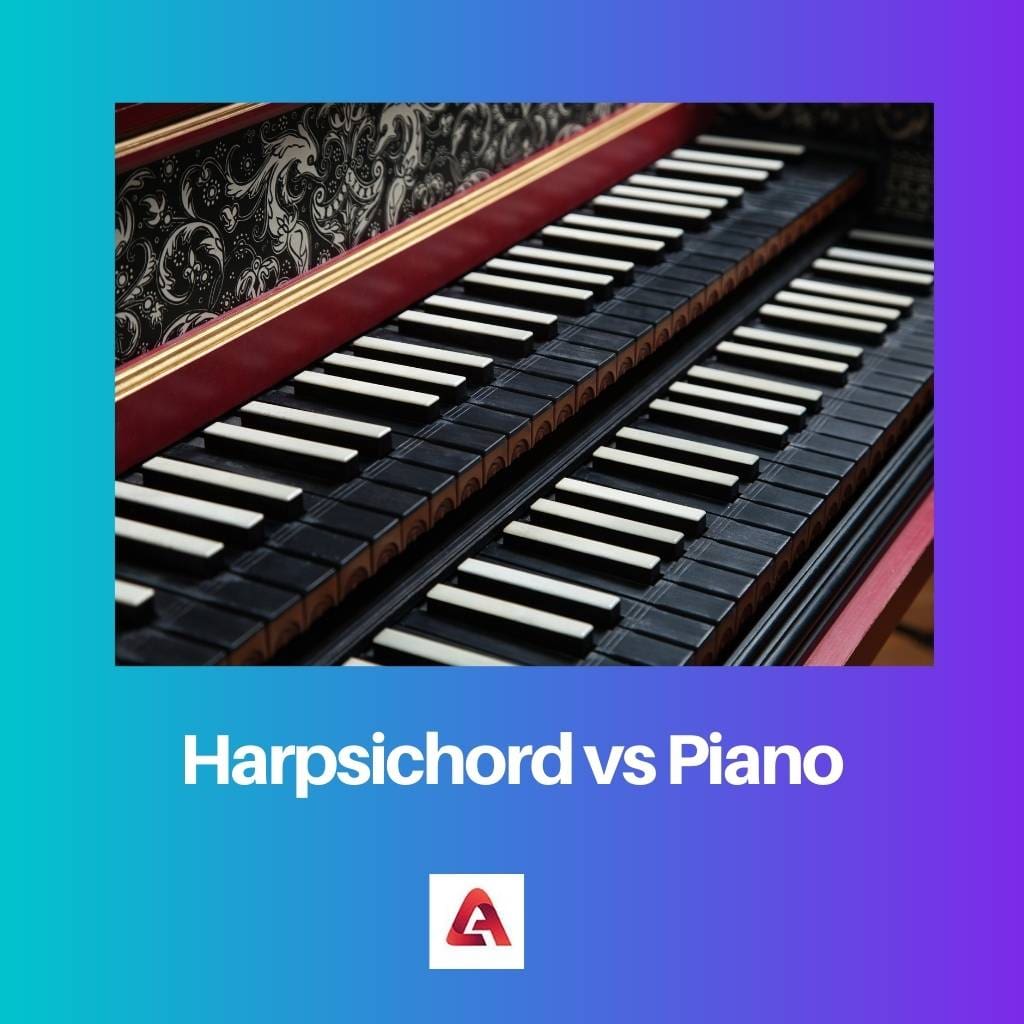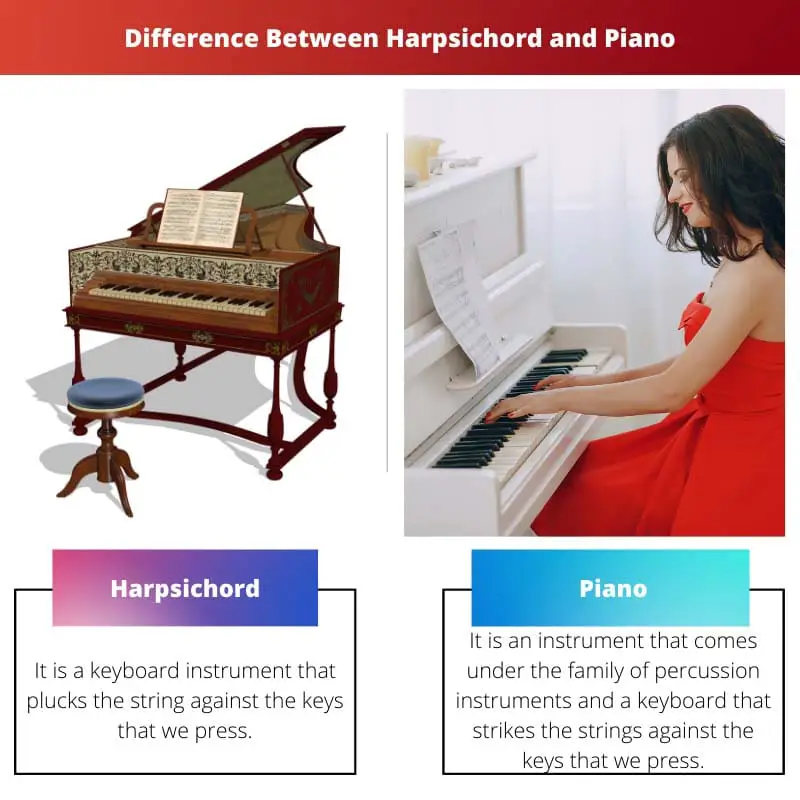Harpsichord and Piano are musical instruments that come under the category of keyboard instruments. With the emergence of Piano, Harpsichord’s usage got declined gradually.
Each country has its own name for Harpsichord played in their respective origins. There are almost the same but differ in their inner mechanisms and sounds.
Key Takeaways
- Harpsichords produce sound by plucking strings with a quill, whereas pianos use hammers to strike strings.
- Pianos allow dynamic control with touch-sensitive keys, while harpsichords lack this feature and produce a consistent volume.
- Harpsichords were popular in the Baroque era, while pianos emerged during the Classical period and remain widely used today.
Harpsichord vs Piano
The difference between Harpsichord and Piano is that they differ significantly in their sounds, mechanisms in which they work, their origin, size and volume, and the number of octaves used. The way both instruments produce sounds also differs in various aspects.

Harpsichord is a musical instrument that operates by plucking the strings against the keys that we press. The harpsichord dates back to the 14th and 15th-century instrument, which was called by different names across the globe.
It was used and originated in Europe. Harpsichord has more than two sets of strings, which amplifies the sounds produced.
The piano is an acoustic instrument that dates back to the 16th century. The ancestral origin of the piano states that it has come from the family of Monochord instruments.
A piano is a string instrument. The piano is also regarded as a percussion instrument due to its striking mechanism against the strings in the horizontal plane.
Comparison Table
| Parameters of Comparison | Harpsichord | Piano |
|---|---|---|
| Definition | It is a keyboard instrument that plucks the string against the keys that we press. | It is an instrument that comes under the family of percussion instruments and a keyboard that strikes the strings against the keys that we press. |
| Origin period | It has its origin around the 14th -15th century. It is a European instrument created in Italy. | It has its origin period around the 16th century. It is an Italian instrument. |
| Mechanism | Harpsichord’s mechanism is plucking the strings behind the horizontal board to produce sounds. | The piano mechanism lies in striking the strings behind the board to produce sounds. |
| Family | Harpsichord comes from the family named Psalterium. | Piano comes from the family Clavichord. |
| Type | Harpsichord is a string instrument. | A piano is a percussion instrument. |
What is Harpsichord?
Harpsichord works by the operation of a plucking mechanism. It has two slots which are in the shape of a wing that helps in plucking the strings against the keys.
This mechanism that helps in the plucking process is named Jack. By adjusting the firmness of the keys, the sounds can be amplified according to the Harpsichordist.
It becomes quite tricky when we are provided with two rows of jacks, in such a case, we would be in need of two keyboards to amplify sounds.
Harpsichords differentiate the colors in the tones of music produced by them in various aspects. The kinds of songs and sounds produced depend on the distance between the strings and plucking mechanisms.
Special effects and sounds can also be produced by the harpsichord instrument, which makes it unique and featured from other instruments. There are various types of unisons and registers employed in the process of mechanisms in Harpsichord.
Harpsichord was invented to observe the harmonic cosmic variations in the body by medical astrologers. It was introduced as a general-purpose instrument that turned into a musical instrument in due course of time. Harpsichord and piano have very similar kinds of origins.

What is Piano?
Piano comes from the Monochord family of instruments. It is a fortepiano which is in a horizontal structure. It is similar to Harpsichord but with few variations.
Dulcimer is regarded to be the same as a piano, in its mechanisms, as its sounds are produced by the vibration of its strings.
The piano is employed with a hammer to strike against the strings. Bartolomeo Cristofori created Piano in the 16th century. The piano produces both soft and loud songs that are found to be very soothing. It is a different kind of instrument that appears to be comfortable while playing it.
The piano has 88 keys and 7 full octaves, which makes it distinguished from Harpsichord. Vibrations of the strings are transferred to the soundboard which is located horizontally to the keys present.
There are many other instruments, but the piano has its own grace and is regarded to be the king of instruments. The piano is many other features has makes it unique and form other kinds of variants.
The piano is available in various forms, even in virtual forms, but it lasts to be a soothing and calming instrument.

Main Differences Between Harpsichord and Piano
- Harpsichord is a string keyboard instrument, whereas the Piano is a percussion keyboard instrument.
- Harpsichord plucks the strings while the keys are pressed. Whereas the Piano hammers or strikes the strings while the keys are pressed.
- Harpsichord is found in the 14th – 15th century, where Piano dates back to the 16th century, which marks the decline in the usage of Harpsichord.
- Harpsichord has less than five octaves, and Piano has more than seven octaves and registers.
- Harpsichord has a thinner or slimmer keyboard when compared to a Piano.
- Sounds produced on a Piano can last for a longer time when compared to a Harpsichord.
- There are no volume variations while playing the Harpsichord, but you can amplify the sounds too soft or louder while playing the Piano.

- https://journals.sagepub.com/doi/abs/10.1177/0305735610376467
- https://search.proquest.com/openview/3bf2f6a3dbd0f1fdd41f9d4ddf97627a/1?pq-origsite=gscholar&cbl=18750&diss=y

The article was highly informative, providing a detailed comparison between the harpsichord and piano. The technical explanations were particularly well-detailed and insightful.
The article’s clarification of the differences in the number of octaves and the distinctive sounds of the harpsichord and piano was very enriching.
I agree, the article’s focus on the detailed mechanisms of sound production in the harpsichord and piano was exceptional. It enhances the understanding of these instruments.
The article presented an excellent overview of the harpsichord and piano, including detailed information about their respective mechanisms and unique sounds.
I appreciated the historical context provided for both instruments and their mechanisms. It gave a well-rounded view of their development.
The descriptions of the mechanisms and unique musical capabilities of the harpsichord and piano were engaging and educational.
The article’s emphasis on the distinctive features of the harpsichord, such as the plucking mechanism and its historical evolution, was truly enriching.
The explanation of the different types of sounds and special effects produced by the harpsichord is fascinating. It highlights the instrument’s unique musical capabilities.
I appreciated the detailed comparison of the number of octaves and the volume range of the harpsichord and piano. It provides a clear distinction between the two instruments.
The detailed comparison table provided a clear distinction between the harpsichord and piano in terms of their definition, origin, and mechanism of sound production.
I found the breakdown of the family origins and types of both the harpsichord and piano highly informative. It added depth to the understanding of these instruments.
The historical information about the origins and families of the harpsichord and piano is very interesting. I appreciate the depth of detail provided in this article.
The explanation of the different types of sounds and special effects produced by the harpsichord is truly enlightening. It shows the complexity and versatility of the instrument.
I find the comparison table very helpful in understanding the key differences between the two instruments.
The historical details about the invention and evolution of the harpsichord and piano provided a comprehensive understanding of their significance in music history.
The article’s comparison of the historical origins and mechanisms of the harpsichord and piano was well-researched and thorough.
The comparison of the historical period and origins of the harpsichord and piano is well-detailed. It helps in understanding the cultural context and evolution of these instruments.
I found the explanation about the family origins of the harpsichord and piano to be intriguing. It speaks to the complexity of their development and classification.
The article provided a thorough understanding of the harpsichord and piano. I was particularly interested in the detailed explanation of how the harpsichord produces sound through plucking and its historical significance.
I agree, the article’s examination of the unique sounds and special effects of the harpsichord provides valuable insight into its capabilities as an instrument.
The article’s focus on the mechanism of sound production in both instruments is commendable. It gives a greater appreciation for the intricacies of musical instruments.
The article provided an insightful comparison between the harpsichord and the piano. It clearly explains the differences in their mechanisms, sounds, and origins.
I completely agree. The detailed explanation of the plucking mechanism of the harpsichord and the hammer mechanism of the piano is fascinating.
The explanation concerning the plucking mechanism of the harpsichord and the striking mechanism of the piano was thorough and illuminating.
I agree, the way the article detailed the different methods of sound production in the harpsichord and the piano was very informative.